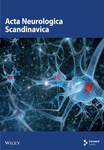An unusually glycosylated form of acetylcholinesterase is a CSF biomarker for Alzheimer's disease
J. Sáez-Valero*
* Current address: Instituto de Neurociencias, Universidad Miguel Hernández, Campus de San Juan, 03550 San Juan de Alicante, Spain
Search for more papers by this authorS. Mok Ss
Dept of Pathology, University of Melbourne, Parkville, Victoria 3052, Australia
Search for more papers by this authorD. H. Small
Dept of Pathology, University of Melbourne, Parkville, Victoria 3052, Australia
Search for more papers by this authorJ. Sáez-Valero*
* Current address: Instituto de Neurociencias, Universidad Miguel Hernández, Campus de San Juan, 03550 San Juan de Alicante, Spain
Search for more papers by this authorS. Mok Ss
Dept of Pathology, University of Melbourne, Parkville, Victoria 3052, Australia
Search for more papers by this authorD. H. Small
Dept of Pathology, University of Melbourne, Parkville, Victoria 3052, Australia
Search for more papers by this authorAbstract
The identification of a biochemical marker of Alzheimer's disease (AD) is a major research aim of many groups. Abnormal levels of tau and Aβ have been identified in the cerebrospinal fluid (CSF) of AD patients, although the sensitivity and specificity of the changes in these two biomarkers alone is not sufficient to be of diagnostic value. Recently, our group has identified an abnormality in the glycosylation of acetylcholinesterase (AChE). The increase in this glycoform of AChE is very specific for Alzheimer's disease and is not seen in many other neurological diseases including other dementias.
References
- 1 Selkoe DJ. Translating cell biology into therapeutic advances in Alzheimer's disease. Nature 1999; 102: A23–A31.
- 2 Lowe J. Establishing a pathological diagnosis in degenerative dementias. Brain Pathol 1998; 8: 403–6.
- 3 Growdon JH. Biomarkers of Alzheimer disease. Arch Neurol 1999; 56: 281–3.
- 4 The Ronald and Nancy Reagan Research Institute of the Alzheimer's Association and the National Institute on Aging Working Group. Consensus report of the Working Group on molecular and biochemical markers of Alzheimer's disease. Neurobiol Aging 1998; 19: 109–16.DOI: 10.1016/s0197-4580(98)00022-0
- 5 Van Nostrand WE, Wagner SL & Shankle WR et al. Decreased levels of soluble amyloid β-protein precursor in cerebrospinal fluid of live Alzheimer disease patients. Proc Natl Acad Sci USA 1992; 89: 2551–5.
- 6 Blennow K, Hesse C & Fredman P. Cerebrospinal fluid apolipoprotein E is reduced in Alzheimer's disease. Neuroreport 1994; 5: 2534–6.
- 7 Pirttila T, Koivisto K & Mehta PD et al. Longitudinal study of cerebrospinal fluid amyloid proteins and apolipoprotein E in patients with probable Alzheimer's disease. Neurosci Lett 1998; 249: 21–4.DOI: 10.1016/s0304-3940(98)00381-4
- 8 Trojanowski JQ, Clark CM, Arai H & Lee V. Elevated levels of tau in cerebrospinal fluid: implications for the antemortem diagnosis of Alzheimer's disease. Alz Dis Rev 1996; 1: 77–83.
- 9 Arai H, Nakagawa T & Kosaka Y et al. Elevated cerebrospinal fluid tau protein level as a predictor of dementia in memory-impaired individuals. Alz Res 1997; 3: 211–13.
- 10 Motter R, Vigo-Pelfrey C & Kholodenko D et al. Reduction of β-amyloid peptide 42 in the cerebrospinal fluid of patients with Alzheimer's disease. Ann Neurol 1995; 38: 643–8.
- 11 Tamaoka A, Sawamura N & Fukushima T et al. Amyloid β-protein 42(43) in cerebrospinal fluid of patients with Alzheimer's disease. J Neurol Sci 1997; 148: 41–5.DOI: 10.1016/s0022-510x(96)00314-0
- 12 De La Monte SM, Ghanbari K & Frey WH et al. Characterization of the AD7C-NTP cDNA expression in Alzheimer's disease and measurement of a 41-kD protein in cerebrospinal fluid. J Clin Invest 1997; 100: 3093–104.
- 13 De La Monte SM, Volicer L, Hauser SL & Wands JR. Increased levels of neuronal thread protein in cerebrospinal fluid of patients with Alzheimer's disease. Ann Neurol 1992; 32: 733–42.
- 14 Kennard ML, Feldman H, Yamada T & Jefferies WA. Serum levels of the iron binding protein p97 are elevated in Alzheimer's disease. Nat Med 1996; 2: 1230–5.
- 15 Massoulié J & Bon S. The molecular forms of cholinesterase and acetylcholinesterase in vertebrates. Ann Rev Neurosci 1982; 5: 57–106.
- 16 Whitehouse PJ, Price DL, Clark AW, Coyle JT & DeLong MR. Alzheimer disease: evidence for selective loss of cholinergic neurons in the nucleus basalis. Ann Neurol 1981; 10: 122–6.
- 17 Small DH, Michaelson S & Sberna G. Non-classical actions of cholinesterases: role in cellular differentiation, tumorigenesis and Alzheimer's disease. Neurochem Int 1996; 28: 453–83.DOI: 10.1016/0197-0186(95)00099-2
- 18 Mesulam MM, Geula C & Morán MA. Anatomy of cholinesterase inhibition in Alzheimer's disease: effect of physostigmine and tetrahydroaminoacridine on plaques and tangles. Ann Neurol 1987; 22: 683–91.
- 19 Sberna G, Sáez-Valero J, Beyreuther K, Masters CL & Small DH. The amyloid β-protein of Alzheimer's disease increases acetylcholinesterase expression by increasing intracellular calcium in embryonal carcinoma P19 cells. J Neurochem 1997; 69: 1177–84.
- 20 Sberna G, Sáez-Valero J & Li QX et al. Acetylcholinesterase is increased in the brains of transgenic mice expressing the C-terminal fragment (CT100) of the β-amyloid protein precursor of Alzheimer's disease. J Neurochem 1998; 71: 723–31.
- 21 Sáez-Valero J, Sberna G, McLean CA & Small DH. Molecular isoform distribution and glycosylation of acetylcholinesterase are altered in brain and cerebrospinal fluid of patients with Alzheimer's disease. J Neurochem 1999; 72: 1600–8.
- 22 Sáez-Valero J, Sberna G, McLean CA, Masters CL & Small DH. Glycosylation of acetylcholinesterase as diagnostic marker for Alzheimer's disease. Lancet 1997; 350: 929.DOI: 10.1016/s0140-6736(97)24039-0
- 23 Fambrough DM, Engel AG & Rosenberry TL. Acetylcho-linesterase of human erythrocytes and neuromuscular junctions: homologies revealed by monoclonal antibodies. Proc Natl Acad Sci USA 1982; 79: 1078–82.
- 24 Flores-Flores C, Martínez-Martínez A, Campoy FJ, Brodbeck U & Vidal CJ. Differential interaction of the monoclonal antibody AE-1 with acetylcholinesterase oligomers and monomers from rabbit muscle microsomes, human brain and fetal bovine serum. Neurosci Lett 1997; 239: 101–4.DOI: 10.1016/s0304-3940(97)00902-6
- 25 Sáez-Valero J, Barquero MS, Marcos A, McLean CA & Small DH. Altered glycosylation of acetylcholinesterase in Alzheimer lumbar cerebrospinal fluid. J Neurol Neurosurg Psych 2000; 69: 664–7.




